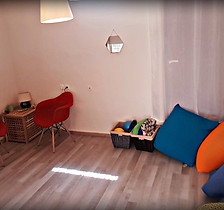
"If I could tell you what I meant, there would be no point in dancing it"
Isadora Duncan

The Clinic for female movement therapy
My name is Ronit Basher Lazar, I am a qualified Dance Movement Therapist (DMT), workshop facilitator and sex therapist. In recent years, I have spent most of my time researching and treating women and female adolescents in diverse spheres. I have experience in both individual and group therapy, specialized treating complex PTSD, eating disorders, mental disorders and body image issues. I also address issues of femininity and self-regulation.
My treatment environment is an inviting and safe environment for dance movement therapy. The environment contains equipment, creative materials and music, and facilitates individually tailored movement and dialogue.
The therapy focusses upon women and girls with issues of body image, PTSD, depression, phobia and dysmorphia who are seeking new ways of coping with them.
Therapy in a suitable environment requires no previous dance or movement experience.
The therapy is available online.

Dance and Movement Therapy
Dance and Movement Therapy (DTM) is a form of psychotherapy that engages body movement and dialogue for an encounter with the mind. Movement facilitates the non-verbal expression of difficulties without breaching defences, as is the case with other expressive and creative methods. DTM adds movement and dance in addition to words, expression, creativity and unprocessed mind content.
Movement marks the beginning of life. It is our first language and it is a person’s primordial, basic means of communication. Before language acquisition, we communicate through our bodies and movement. Throughout our lives, significant experiences, memories, trauma and events are etched into our bodies. They constitute our lives’ ledger. Parts of the ledger remain unprocessed, untranscribed or unsymbolised within our bodies. They create formless spaces within our bodies or minds.
The very act of movement is therapeutic. The use of movement in creative expression forms a major part of the therapy and the renewed engagement with the individual’s self. Also, the use of movement facilitates a mind bypassing encounter with the unknown.
It is thus that movement releases inhibitions, eases discomfort, and reconnects us with our most complete desires, urges and selves.
The chance to encounter the mind at its most primordial level, in a kindly, safe and accepting environment opens up a path for change and healing.
Anyone of any age wanting or feeling the need for change can benefit from DTM. It is especially beneficial in cases of physical trauma, preverbal trauma, somatic symptom disorder, body and self-image issues, and in cases where language is less accessible.
Creative Arts Therapies
(from the Israeli Association for Creative Arts Therapies (YAHAT) website)
Creative arts therapists work with a diversity of people from infants to the elderly. They address a range of mental health and other issues, such as autism, trauma, learning disorders and at-risk youth. Therapies are provided at individual, dyadic and group levels. They may be dynamic, systemic or cognitive behavioural, depending upon the training and expertise of the individual therapist.
Creative arts therapies are designed to foster mental strength and to reinforce coping and acclimatisation skills, with a view to enhancing the quality of life and optimising individual functionality.